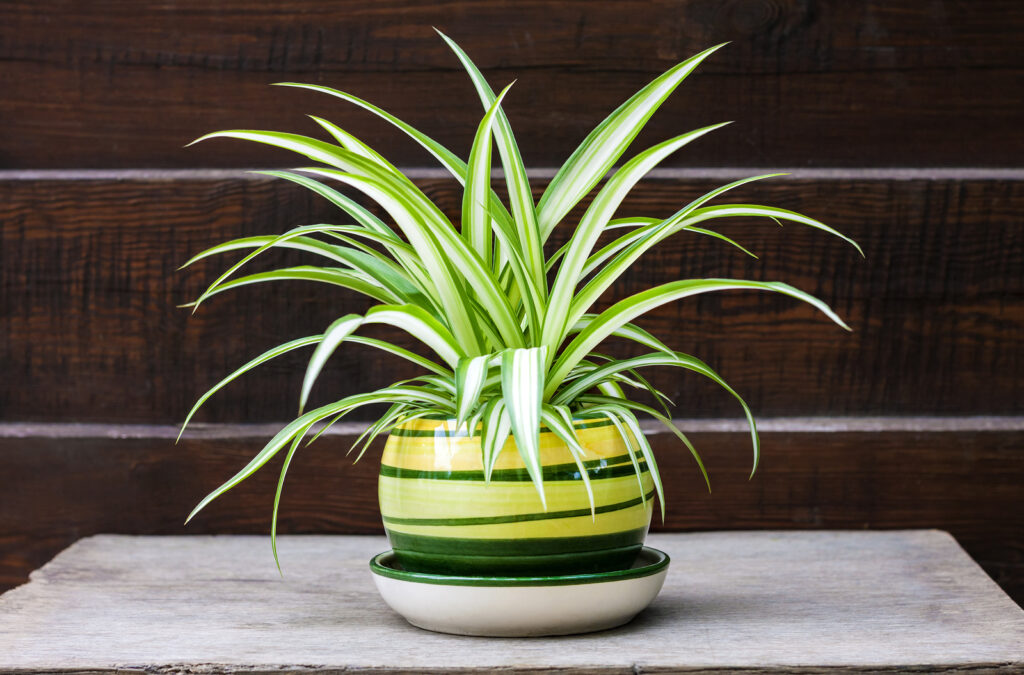Chlorophytum–commonly called Spider Plant–is a tropical perennial relative of the lily grown as a houseplant. The plant grows in soft clumps with long curving leaves. Plantlets grow at the end of wiry stems and are easily snipped off and rooted to create new plants.
Chlorophytum is a genus of 60 tropical herbs. They are native to the warm section of Asia, Africa, and America. They are grown as house plants in cool temperate regions.
Flowers are borne in graceful sprays of white, green, or cream, and the foliage of some species is strikingly baned with yellow.
Chlorophytum can be propagated by seed, suckers, or offsets from the lower stem, and by division in spring.
Chlorophytum is a genus of about 250 species of evergreen rhizomatous perennials with fibrous roots.
Get to know Chlorophytum
- Plant type: Tropical perennial
- Growing Zones and range: 10-11
- Optimal growing temperature: day 68°F to 75°F (20°-24°C), night 60° to 68°F (16°-20°C).
- Height and width: 6 to 12 inches tall and wide; wiry stems cascade to 3 feet
- Foliage: Long strappy, striped leaves from long, pale yellow stems
- Flowers: Small white flowers along the length of stems
- Uses: Hanging plant, houseplant
- Common name: Spider Plant, airplane plant, ribbon plant, spider ivy
- Botanical name: Chlorophytum comosum
- Family: Liliaceae
- Origin: South Africa and West Africa
Where to plant Chlorophytum
- Chlorophytum need medium light; avoid strong, direct sun
- Indoors Chlorophytum was bright to moderate light from any exposure; does well under artificial light, needing 14 to 16 light-hours daily.
- Plant Chlorophytum in all-purpose mix

How to water and feed Chlorophytum
- Allow the soil to dry out slightly between waterings.
- Fertilize Chlorophytum weekly with a mild liquid fertilizer..
Chlorophytum care
- Tips of leaves turn brown the plant is underwatered. Some kinds of tap water can cause brown leaf tips.
- Trim dead leaves or leaf ends with a scisoors.
- Chlorophytum can quickly outgrow its pot; repot at least once a year or as soon as the plant is tight in its pot.
Growing Chlorophytum as a houseplant
- Give Chlorophytum bright light throughout the year.
- Provide average humidity and average room temperature.
- Allow the soil to dry to the touch between thorough waterings.
- Apply fertilizer weekly during the growing season; use a water soluble fertilizer at half strength.
Chlorophytum pests and diseases
- Chlorophytum is susceptible to damage by scale insects.
- Chlorophytum is prone to leaf burn from excess salts, fluoride, or dry soil.
Chlorophytum propagation
- Stems produce “plantlets” that can be snipped off and will root in water. Rooted seedlings can be transplanted to pot with potting mix.
- Propagate by layering.
- Divide the parent plant or grow new plants from seed. Sow seed at about 64°F (18°C).
Chlorophytum varieties to grow
- Chlorophytum capense. Clump-forming perennial with lance or strap-shaped bright green leaves; grow to 12 inches high and 24 inches wide.
- C. comosum, ribbon plant, spider plant. Clump-forming perennial with lance or strap-shaped bright green leaves; grows 6 to 8 inches tall and 6 to 12 inches wide. Cultivars include: ‘Vittatum’ has green leaves with stripes down the center; ‘Mandaianum’ is compact with yellow-striped leaves.



